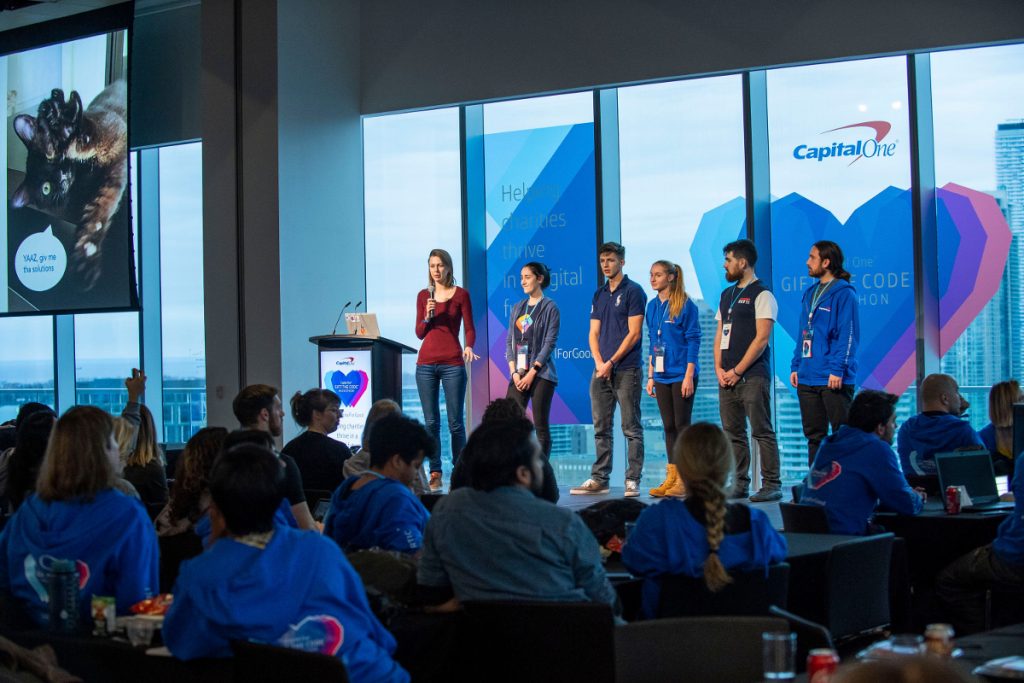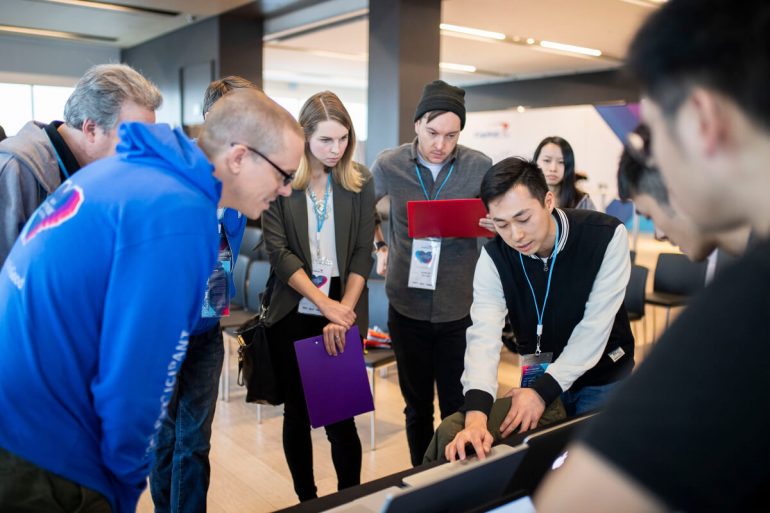Gift the Code is an annual hackathon run by Capital One dedicated to solving problems for non-profit and charity organizations using technology. Six charities participated in the most recent Gift the Code, with over 200 people representing 34 teams on hand to help Kids Help Phone, the Movember Foundation, Camp Quality, the Boys & Girls Clubs of Canada, the Centre for Mindfulness Studies, and Toronto Cat Rescue.
While each winning team delivered a viable solution for their respective organization, two teams stood out as examples of the different paths development can take. Featuring both complex and simple solutions, Team PoMo and Team Awesome, helping Kids Help Phone and Toronto Cat Rescue, respectively, embodied the startup spirit of listening to their users.
A two-sided solution
“When people talk online about Kids Help Phone, or online therapy in general, the sentiment is that it doesn’t work because of the long queues,” said Nive, a member of Team PoMo, the winning team for Kids Help Phone. “So, if we can implement a solution a lot of people would benefit.”
The team’s solution was a gamified digital waiting room. Targeted towards children from ages 4-10, which Kids Help Phone data showed were disengaging the most, the solution offered them the chance to play games, fill out short quizzes, and share more about who they are and how they are feeling.
“If we were to deploy this winning solution in the next few months, it would dramatically improve the experience that kids have.”
– Ted Kaiser,
Kids Help Phone
Alfred, Jacob, and Nive on Team PoMo all cited a desire to help kids get better care as the reason for choosing to hack for Kids Help Phone. Jacob, previously a kindergarten and grade one teacher, had experience developing games to keep kids engaged. Nive, a mental health advocate, took inspiration from how online therapy companies use chatbots to keep users engaged while waiting for a counsellor. Alfred cited a personal desire to make care more efficient for young people.
On the other hand, Raymond and Donny were concerned about counsellors. Raymond saw, based on personal experience and Kids Help Phone data, that counsellors were “overwhelmed by long queues – they don’t know what to do.” Donny added that you could make a website enjoyable for kids, but unless it was also collecting data and helping counsellors “handle all the different tasks” related to intake, the solution would be incomplete.
So Team PoMo also built a real-time dashboard, which would continuously update counsellors with new information on kids in the queue as they answered questions about themselves. The dashboard also provided a severity profile for each child, making it easier for counsellors to quickly get to kids who needed help.
“You could tell that [Team PoMo] had thoughtful analysis at the outset to understand the challenges and use cases,” said Ted Kaiser, VP of Innovation and Technology at Kids Help Phone, and one of the judges for the hackathon. “The solution clearly understood the data we provided and fit what both the users and the organization needed. If we were to deploy this winning solution in the next few months, it would dramatically improve the experience that kids have.”

Focus on impact over cutting-edge tech
In contrast to Kids Help Phone’s rich dataset, Toronto Cat Rescue has operated off one shared Google Sheet, managing over 2500 cat recuses and adoptions involving more than 900 volunteers per year. While there was no historical data available to find trends, Team Awesome was still able to provide a user-focused solution.
That winning solution was a scalable, user-friendly intake form for cats coming into Toronto Cat Rescue shelters. The form lets volunteers easily log pertinent information about the cats without requiring any advanced technology prowess. On the backend, the information updated in real time to a database so administrators could get a bird’s eye view of how each shelter was doing.
“Gift the Code draws a lot of young, talented, caring people. It’s incredible the degree to which the developers and team members care about what we’re trying to do.”
“We asked the Toronto Cat Rescue team a lot of questions,” said Jennifer, a student who was part of Team Awesome. “They mentioned a lot how they didn’t want the most cutting-edge [technology] because a lot of volunteers didn’t know how to work that. They wanted something that would last a long time with little room for error.”
Tessa, a UX designer at a creative agency in Toronto, added that the Toronto Cat Rescue team was available throughout the hackathon for in-depth questions, which made all the difference when it came to building Team Awesome’s solution.
“It has to be useful for them,” she said. “They don’t have a big budget so we can’t get all these fancy technologies and paid services in there. They are comfortable using Google Sheets already so that contributed to our decision to build on top of that and make it easy for them to keep working with it.”
Instead of trying to force cutting-edge ‘innovation’ onto Toronto Cat Rescue, Team Awesome asked questions, built, and then asked more questions. By iterating along the way with the non-profit’s needs at the forefront, the team was able to build an elegant, lightweight, and scalable solution that will have real impact for Toronto Cat Rescue.
“The solution that came up was so simple yet so elegant because it builds on something as fundamental as Google Sheets, but provided a front end so people who volunteer don’t need to have any tech expertise,” said Azraa Zoomerwalla, a “charity champion” with Capital One, who volunteered to help craft the hackathon challenges and guide teams through strategic problem solving. “It streamlines the entire system so you have more volunteers available to do actual cat care work and less data administration work.”
Lessons learned
Innovation comes in many shapes and sizes, and the biggest impact doesn’t always come from cutting-edge tech or complex solutions. With a simple focus on user needs, Teams PoMo and Awesome built elegant solutions that have the potential to impact lives across the country.
It’s a lesson every tech company, big and small, should take to heart. But it wasn’t the only lesson to be learned at Gift the Code. With most charities stretching every dollar to support their cause, hackathons like Gift the Code demonstrate that tech can be a powerful tool for social change, improving efficiencies and involving more people.
“Gift the Code draws a lot of young, talented, caring people,” said Kaiser. “It’s incredible the degree to which the developers and team members care about what we’re trying to do.”
BetaKit is a Gift the Code media partner and this article is sponsored by Capital One.


